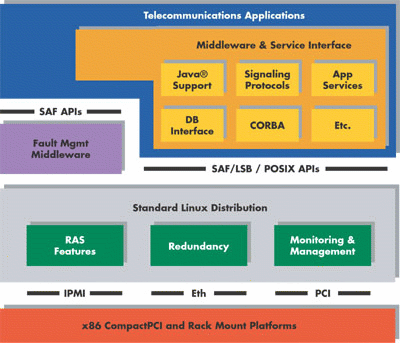Article: A new era: Carrier grade Linux for Telecommunications
Apr 8, 2002 — by LinuxDevices Staff — from the LinuxDevices Archive — 1 viewsIn January, at Linux World in New York, a group of major global corporations — including semiconductor manufacturers Intel and IBM, and equipment providers Nokia, Alcatel, and Cisco — announced that they were joining forces with the Open Source Development Lab to define a common industry… specification for a new class of software called carrier-grade Linux.
Carrier-grade is a term for public network telecommunications products that require up to 5 or 6 nines (or 99.999 to 99.9999 percent) reliability, which translates into between 30 seconds (6 nines) and 5 minutes (5 nines) of downtime per year. The term “5 nines” is usually associated with carrier-class servers, while “6 nines” is usually associated with carrier-class switches.
Carrier-grade Linux is a newly emerging category of Linux, which is more robust than the “garden-variety” enterprise-class Linux. It promises to provide a standards-based, open architecture software platform for converging telecommunications/data communications systems, which demand virtually zero down time.
In today's economy, Network Equipment Providers (NEPs) are being pushed to deliver their next-generation solutions with faster time-to-market and at a reduced cost. Linux is the best answer to their problems for all of the obvious reasons. Open source Linux doesn't lock the NEPs into one supplier or one methodology, and frees them to deliver technology faster, at a higher quality, and with lower overall cost.
Traditionally, large telephony applications have been multi-tiered designs controlled by various versions of Unix. These can be easily ported to Linux. Small proprietary RTOSes controlled the lower-level line card communications applications, and Sun Solaris dominated the back-end servers. Today, these same equipment providers are now looking to Linux for their next-generation designs, not just to migrate existing back-end Unix applications, but to address their entire range of applications — from line cards, to gateways and softswitches, to billing and call management applications.
These equipment providers not only appreciate the robust platform that Linux provides, but seek to leverage Linux's programming model and APIs to support their large development teams and to ease migration from other OSes. They look to Linux for both embedded support and end-to-end integration, spanning from the Central Office (CO) to Linux-based ISP/ASP/Enterprise applications.
Today's more advanced networking and control plane processors need superior integrated IP networking, which is native to Linux. Such processors typically have very limited real-time needs, which are easily met by today's more sophisticated versions of embedded Linux. In addition, since Linux has access to TCP/IP communication component stacks, much of the work to enable communications support has already been completed and done in a well understood and standardized manner.
Linux is an ideal housekeeping operating system for sophisticated control plane tasks such as configuration management and out-of-band routing. In addition, Linux is amenable to difficult enterprise-level interfaces. It can take over entire central office networking management and middleware, and easily interconnect with CORBA, SNMP, Web Interfaces, Java, and even Microsoft SQL.
Linux is already becoming the embedded operating system of choice for many high-end communications infrastructure applications. In fact, 12 of the 15 globally recognized telecommunications service providers are already prototyping and building Linux-based systems. Today, embedded Linux is primarily in demand for control plane and management controllers. But many industry observers believe Linux will soon migrate to network processors in the data plane and to the back-end servers dominated by Sparc and Solaris today.
The telecommunications equipment providers, however, want a product that is tailored to their market; they don't want to just “stuff” a commercial Linux server product into a highly critical piece of equipment such as a control blade for a Class 4 switch. Some of the key characteristics required by this new class of carrier-grade Linux are that it must be highly available and robust, based on existing and emerging open standards, have significant third-party software support, and be easily embedded.
Carrier-grade embedded Linux will be the first Linux platform to offer high-level server fault resilience, with multiple solutions for clustering and distributed computing, and technology that descends to line-level interfaces. Systems built with carrier-grade class Linux products should support next-generation PICMG compliant systems with Ethernet backplanes, board-level hot-swap and hot-insertion, multi-medium redundant networking (bonding 10/100/1G Ethernet, CPCI backplane, LANE, etc.), software and hardware RAID, publish-and-subscribe event management, water-marking, and other “hardened kernel” features.

MontaVista's Carrier-grade Linux for Telecommunications software architecture
Groups such as the Open Source Development Lab and the Service Availability Forum are working hard this year to define industry standards for carrier-grade Linux that will define the future of telecommunications and Internet infrastructure. As these standards and specifications emerge, and as the equipment providers increase their adoption of Linux, the role carrier-grade Linux will play in this future promises to be one of great significance.

This article was originally published on LinuxDevices.com and has been donated to the open source community by QuinStreet Inc. Please visit LinuxToday.com for up-to-date news and articles about Linux and open source.